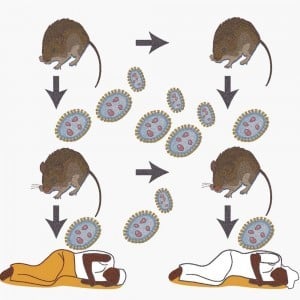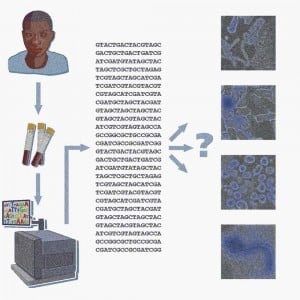 In the arms race between host and pathogen, there can only be one winner. Unfortunately for the human host, when the opponent is a highly severe virus, the result is often in favor of the pathogen. With a primary focus on West Nile, Zika, Ebola, and Lassa viruses, we investigate why this is the case by providing system-wide understandings of the interaction and co-evolution between host and pathogen. We use this knowledge to gain deep insights into how viruses cause outbreaks, how outbreaks develop, and how evolutionary pressures can change the viruses themselves. Our hope is that we can use this knowledge to transform infectious disease outbreak response and change the way we develop vaccines and therapeutics.
In the arms race between host and pathogen, there can only be one winner. Unfortunately for the human host, when the opponent is a highly severe virus, the result is often in favor of the pathogen. With a primary focus on West Nile, Zika, Ebola, and Lassa viruses, we investigate why this is the case by providing system-wide understandings of the interaction and co-evolution between host and pathogen. We use this knowledge to gain deep insights into how viruses cause outbreaks, how outbreaks develop, and how evolutionary pressures can change the viruses themselves. Our hope is that we can use this knowledge to transform infectious disease outbreak response and change the way we develop vaccines and therapeutics.
Using the same sequencing-based technologies utilized in our virus studies, we also develop computational tools and experimental methods that allow us to perform unbiased surveys of the microbes present in human samples. Leveraging these tools and technologies enables us to get a detailed picture of the viruses and microorganisms infecting the human host. We hope that this research will enable us to develop fast, accurate, and unbiased diagnostic platforms that will help us revolutionize personalized care and precision medicine.
We are big believers in open science, so if this research sounds interesting to you, head over to our Projects & Data page for an up-to-date view of ongoing projects and the data we’re producing.
Genomic Epidemiology Reveals Multiple Introductions of Zika virus into the United States
Nature 546(7658):401-405 (2017)
The Evolution of Ebola virus: Insights from the 2013-2016 Epidemic
Nature 538(7624):193-200 (2016)
Clinical Sequencing Uncovers Origins and Evolution of Lassa virus
Cell 162(4):738-750 (2015)
Genomic Surveillance Elucidates Ebola virus Origin and Transmission during the 2014 Outbreak
Science 345(6202):1369-72 (2014)
Outbreak Response & Host-pathogen Evolution
 The interaction between a pathogen and its host is an evolutionary arms race of ever-changing components. Vast arrays of receptors are produced by B- and T-cells of the host adaptive immune system to detect and clear the pathogen. In response, mutations arise within parts of the pathogen’s genome recognized by these receptors. These mutations are positively selected and accumulate at a rapid rate, often leading to immune escape. What are the mechanisms governing the interaction between these partners? Why is a pathogen successful in some hosts, but not in others? What does these signatures tell us about outbreak dynamics? How can we use this knowledge to develop new therapeutics? Advances in metagenomic next-generation sequencing (mNGS) have revolutionized our ability to survey genetic variation in hosts and microbes allowing us to address these fundamental questions.
The interaction between a pathogen and its host is an evolutionary arms race of ever-changing components. Vast arrays of receptors are produced by B- and T-cells of the host adaptive immune system to detect and clear the pathogen. In response, mutations arise within parts of the pathogen’s genome recognized by these receptors. These mutations are positively selected and accumulate at a rapid rate, often leading to immune escape. What are the mechanisms governing the interaction between these partners? Why is a pathogen successful in some hosts, but not in others? What does these signatures tell us about outbreak dynamics? How can we use this knowledge to develop new therapeutics? Advances in metagenomic next-generation sequencing (mNGS) have revolutionized our ability to survey genetic variation in hosts and microbes allowing us to address these fundamental questions.
We are taking advantage of these tools, in combination with a well established network of collaborators and collection sites across West Africa and South America, to uncover the mechanisms that underpin this arms race. We employ mNGS, experimentation and evolutionary theory to conduct research on West Nile virus, Zika virus, Ebola virus, and Lassa virus infections. Based on our large-scale datasets, we perform system-level analyses to understand how the viruses emerge and spread during outbreaks, and how they interact and co-evolve with the host adaptive immune system. A quantitative understanding of the underlying co-evolutionary mechanisms will contribute to the prevention and treatment of human pathogens, and will provide insights into how genetic diversity leads to pathogen emergence.
We have shown how Zika virus spread across the Americas (Metsky et. al, Nature 2017; Faria et. al, Nature 2017) and into the U.S. (Grubaugh et. al, Nature 2017; Quick et al, Nature Protocols 2017). Our research also showed how Ebola virus spreads and evolves over the course of an outbreak (Gire et. al, Science 2014; Park et. al, Cell 2015; Diehl et. al, Cell 2016; Holmes et. al, Nature 2016; Dudas et al, Nature 2017). We have also described how Lassa virus evolves within individuals and how that interferes with its transmission between hosts (Andersen et. al, Cell 2015). Many of the mutations that we observe in the virus genomes appear to be under positive selection from both B- and T-cell mediated pressures. We found that these selection pressures appear to be similar in both infected patients, as well as in virus reservoirs. This is surprising, as human patients are believed to carry the virus only for a short period of time, whereas reservoirs are known to be infected asymptomatically for life. These observations suggest that each infected host is driving positive selection in the virus population, and that individual mutations may confer fitness advantages by enabling viral immune escape.
Using virus genomic sequencing, we investigate how and when these mutations originate in West Nile virus, Zika virus, Ebola virus, and Lassa virus genomes, and how they might confer fitness advantages. Using virus genomic signatures allows us to gain unprecedented insights into the beginnings and dynamics of infectious disease outbreaks. In addition, using mNGS, we follow the host dynamics of B- and T-cells, to get a complete picture of the co-evolution between host and pathogen over an extended period of time. Using a combination of field work, experimentation, and computational biology, we investigate samples obtained from human patients and natural reservoirs with West Nile virus, Zika virus, Lassa virus and Ebola virus.
By obtaining a complete understanding of intrahost viral dynamics and the architecture of effective immune networks, it is our hope that we will be able to help transform outbreak response and inform the future development of effective vaccines and novel therapeutics.
Tracking Virus Outbreaks in the Twenty-first Century
Nature Microbiology 4(1):10-19 (2019)
Genomic Epidemiology Reveals Multiple Introductions of Zika virus into the United States
Nature 546(7658):401-405 (2017)
Establishment and Cryptic Transmission of Zika virus in Brazil and the Americas
Nature 546(7658):406-410 (2017)
Zika virus Evolution and Spread in the Americas
Nature 546(7658):411-415 (2017)
Virus Genomes Reveal Factors That Spread and Sustained the Ebola Epidemic
Nature 544(7650):309-315 (2017)
Ebola virus Glycoprotein with Increased Infectivity Dominated the 2013-2016 Epidemic
Cell 167(4):1088-1098 (2016)
The Evolution if Ebola virus: Insights from the 2013-2016 Epidemic
Nature 538(7624):193-200 (2016)
Clinical Sequencing Uncovers Origins and Evolution of Lassa virus
Cell 162(4):738-750 (2015)
Ebola Virus Epidemiology, Transmission, and Evolution during Seven Months in Sierra Leone
Cell 161(7):1516-26 (2015)
Genomic Surveillance Elucidates Ebola virus Origin and Transmission during the 2014 Outbreak
Science 345(6202):1369-72 (2014)
Unbiased Pathogen Discovery
 When the ‘Spanish Flu’ struck in 1918, little was known about how infectious diseases emerge and spread. It was only later in the outbreak that H1N1 influenza virus was universally accepted as the causative agent, and not as some believed the bacterium Haemophilus influenzae. Today we have a much better understanding of how pathogens emerge and transmit. As a consequence of increasing globalization, rapid expansion of travel and trade, however, pathogens are also expanding their geographical ranges and appearing in new settings. The 2013-2015 Ebola epidemic is a stark reminder that rapid detection and containment of emerging pathogens are required to prevent large-scale outbreaks.
When the ‘Spanish Flu’ struck in 1918, little was known about how infectious diseases emerge and spread. It was only later in the outbreak that H1N1 influenza virus was universally accepted as the causative agent, and not as some believed the bacterium Haemophilus influenzae. Today we have a much better understanding of how pathogens emerge and transmit. As a consequence of increasing globalization, rapid expansion of travel and trade, however, pathogens are also expanding their geographical ranges and appearing in new settings. The 2013-2015 Ebola epidemic is a stark reminder that rapid detection and containment of emerging pathogens are required to prevent large-scale outbreaks.
Unbiased metagenomic sequencing using next-generation sequencing (mNGS) has the potential to transform virus discovery because it does not depend on culturing the pathogen or a priori knowledge of the pathogen’s nucleic acid sequence. More generally, it has the potential to elucidate the complete human virome and microbiome – including viruses that cause no overt symptoms of disease, but may have unrecognized immunological or developmental consequences. mNGS-based methods for microbial discovery and surveillance has also changed our view of the diversity and size of the microbial world. Not only can we now find and characterize disease agents in an unbiased (culture-independent) way, we can also rapidly survey ourselves and the environment.
We have previously used mNGS-based methods to identify likely causal pathogens in Ebola-suspected patients, as well as identified the diversity of co-infections present in Ebola patients (Gire et. al, Science 2014; Andersen et. al, in preparation). These studies identified known pathogens that were unknown in the patients, but unbiased mNGS-based surveys can also be used to discover hitherto unknown organisms infecting humans. We previously used mNGS to discover two novel Rhabdoviruses that were only 35% identical to previously identified viruses (Stremlau et. al, PLoS Negl Trop Dis 2015).
Despite these advances, the current tools are far from optimal and are constrained by low sensitivity and specificity. The Andersen Lab is therefore developing new computational tools to significantly improve our ability to survey and detect known and unknown pathogens infecting humans. We aim to combine these better bioinformatics pipelines with continued technology development, which will allow us to develop early-detection systems to prevent future outbreaks and help gain a better understanding of the organisms infecting humans.
Discovery of Novel Rhabdoviruses in the Blood of Healthy Individuals from West Africa
PLoS Negl Trop Dis 17;9(3):e0003631 (2015)
Genomic Surveillance Elucidates Ebola virus Origin and Transmission during the 2014 Outbreak
Science 345(6202):1369-72 (2014)
Identifying Recent Adaptations in Large-Scale Genomic Data
Cell 152(4):703-713 (2013)
Microbe Hunting
Microbiol Mol Biol Rev 74(3):363-77 (2010)
The Changing Face Of Pathogen Discovery And Surveillance
Nat Rev Microbiol 11(2):133-41 (2013)

